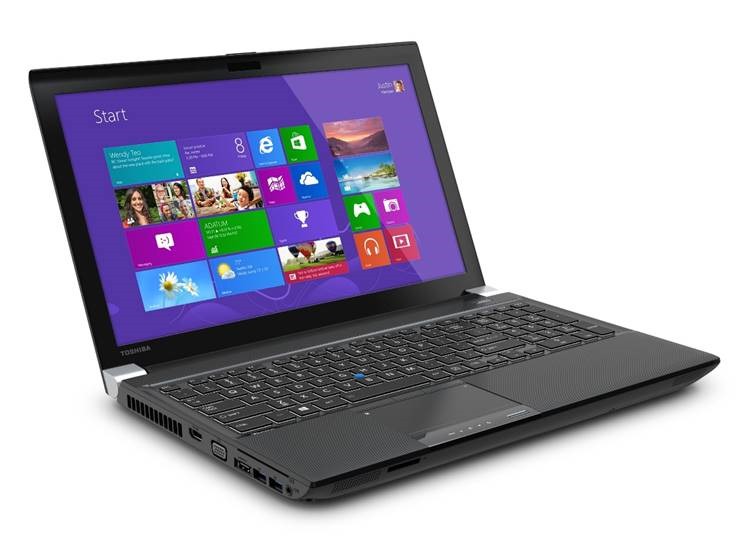Toshiba Intros First Ultra HD 4K Laptops
These two laptops are slated to launch in mid-2014.
This week during CES 2014, Toshiba introduced what it deems as the world's first laptops featuring Ultra HD 4K displays: the Tecra W50 and the Satellite P50t. Toshiba indicates that the former is ideal for engineers and 3D designers, while the latter will be great for 4K movie enthusiasts and professional photographers.
"The 15.6-inch diagonal displays of the Tecra W50 and Satellite P50t deliver native 3840 x 2160 resolution at 282 PPI. To further enhance the viewing experience, the displays are also color calibrated with accurate color gamut and feature wide viewing angles," reads the company's press release.
Unfortunately, Toshiba isn't coughing up a list of specs just yet, as both products aren't due to arrive until mid-2014. However, Microsoft provides some insight, reporting that the Tecra W50 will pack a fourth-generation Intel Core "Haswell" processor, and a Nvidia Quadro K2100M GPU with 2 GB of dedicated memory. This model is also bulkier than the Satellite P50t, weighing less than six pounds.
The more consumer friendly Satellite P50t, according to Toshiba, will be packed with premium features and "sophisticated" styling. The company reveals even less about this model, only reporting that it will have an Intel Core "Haswell" processor and support for touch-based input. This laptop was designed to "kick mobile entertainment into high gear."
"The 4K Ultra-HD screen that's available with the Satellite P50t will also feature edge-to-edge glass with amazing color, clarity, and contrast," says Microsoft's Gavin Gear.
Toshiba is likely showcasing these two laptops on the CES 2014 show floor this week. We expect to see more hardware details pop up towards the launch window.
Check out all of our CES 2014 coverage!
Get Tom's Hardware's best news and in-depth reviews, straight to your inbox.

Kevin Parrish has over a decade of experience as a writer, editor, and product tester. His work focused on computer hardware, networking equipment, smartphones, tablets, gaming consoles, and other internet-connected devices. His work has appeared in Tom's Hardware, Tom's Guide, Maximum PC, Digital Trends, Android Authority, How-To Geek, Lifewire, and others.
-
MrBreakyourFace Because we have been stuck at 1080p on laptops for years ? Also, surprised more laptops (especially gaming ones) haven't included 1440p displaysReply -
Innocent_Bystander-1312890 Now if Microsoft would only fix their horrible DPI scaling or made their UI scale as vector graphics these screens would actually start making sense... until then, your best bet for a 15" screen (if you also want to be able to read it without eye strain) is 1600x900.IBReply -
smeezekitty Reply
+112395158 said:Now if Microsoft would only fix their horrible DPI scaling or made their UI scale as vector graphics these screens would actually start making sense... until then, your best bet for a 15" screen (if you also want to be able to read it without eye strain) is 1600x900.IB
all these mega high resolution displays on tiny screens where you cannot even see the UI elements.
And why the lack of desktop monitors that do these high resolutions of cheap and in smaller sizes?
-
lp231 High resolutions on a small size screen will not work, the text is way too small. I've tried it before with on a MBP Retina 13" running Win7 with a native resolution of 2560x1600, it needs a high power magnifier just to be able read it.Reply -
vmem it is unfortunate that hardware manufacturers had to do this before proper DPI is implimented. windows 8.1 itself is fine, that is if you ONLY use micrososft hardware (and if you do, I recommend you get a macbook pro). until things like adobe scale properly... a 4k monitor destroys productivity on a laptopReply -
chicofehr I would prefer a 40" 4K monitor with 100% Adobe RGB etc. I got the 30" and find the 1600p good enough for that size. Super high res work better for tablets and phones where u have your eyes within inches of it where that might make some sense. Laptop/desktop you are often 2+ feet from screen so this 4K small screen is useless.Reply -
icemunk The high resolution monitors beyond 1080p are a great big rip off right now. Hopefully the new 4K TVs will drive down the price of monitors as well.Reply -
JD88 Once the scaling issue get worked out, this is still a pretty big deal. I encourage anyone to take their 1080p 300+ ppi smartphone and hold it up next to their notebook monitor. Once you do that, you'll see the huge difference. This is less important on a desktop where you're further back, but on a notebook it is necessary.Reply

